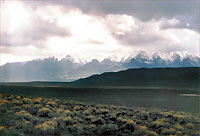|
The Club blows by its wildland goals and helps protect more land than it planned to.
By Kim Todd
 The
U.S. map on the wall of Melanie Griffin's office in Washington, D.C.,
represents much more than just highways and state boundaries. Griffin,
director of the Club's lands protection program, can look up and see
senators who need convincing, areas where campaigns are going well
and districts where votes are lacking on a key wildlands bill. By
the end of last year, though, a glance at her map revealed millions
of acres of protected land. The
U.S. map on the wall of Melanie Griffin's office in Washington, D.C.,
represents much more than just highways and state boundaries. Griffin,
director of the Club's lands protection program, can look up and see
senators who need convincing, areas where campaigns are going well
and districts where votes are lacking on a key wildlands bill. By
the end of last year, though, a glance at her map revealed millions
of acres of protected land.
The victories are there in high-desert plants thriving on Steens Mountain, chinook salmon swimming through the Hanford Reach of the Columbia River, and coral reefs surrounding the Hawaiian Islands.
By any measure, the Wildlands Campaign has had a banner year. Perhaps the most impressive yardstick is the campaign's stated goals.
Two years ago, at a planning meeting in West Virginia, organizers decided they wanted to shoot for three new national monuments. They got 11 and counting.
They planned to defend wild areas by making President Clinton's wild forest roadless initiative a success. Crowds of activists in Sierra Club hats descended on Forest Service hearings last summer, proving the Club's grassroots are stronger than ever and ensuring a plan that offered real protection. (See Wild Forest Win.)
They aimed to secure a billion dollars for the administration's Land Legacy Initiative, including full funding for the Land and Water Conservation Fund which helps buy lands that are currently threatened. The interior appropriations bill that passed in October budgeted $12 billion over six years for the LWCF and other crucial conservation programs, with $540 million for the LWCF in 2001.
Thanks to a president eager to leave a conservation legacy and sometimes in spite of a reluctant Congress, victories went beyond the bounds of the two-year plan. In addition to the national monuments, wilderness bills passed in Oregon, Virginia and Colorado. Eighty-four million underwater acres around Hawaii were established as an ecosystem reserve.
Other places attracted the media spotlight, increasing their likelihood of protection in the future.
In Maine, the Club conducted a survey that showed 63 percent in favor of a Maine Woods National Park, a statistic that garnered two-inch-high newspaper headlines and gave a boost to the flagging campaign.
 "It
brought the whole issue alive again," said Carole Haas, conservation
co-chair for the Maine Chapter. "The opponents complained so much
that people thought the idea was dead, but the survey showed that
the loud opposition is only that - loud." "It
brought the whole issue alive again," said Carole Haas, conservation
co-chair for the Maine Chapter. "The opponents complained so much
that people thought the idea was dead, but the survey showed that
the loud opposition is only that - loud."
A map and report highlighting threatened areas visited by the Lewis and Clark Expedition, color postcards of roadless areas urging public comment and a new video called "Wildland," featuring six national treasures and Sierra Club President Robbie Cox, built support for preserving wild places.
Plans for the future include defending against attacks on areas such as the Arctic National Wildlife Refuge and safeguarding this year's gains by making sure funds are earmarked for the roadless area initiative and other conservation measures. With the additional LWCF funds, agencies will be drafting lists of lands to buy and the Club wants to be sure to offer input.
The increasing number of Jet Skis, snowmobiles and all-terrain vehicles tearing over the landscape is forcing another issue into the forefront.
"A big thrust is going to be appropriate and responsible recreation," said Griffin. "It's a big and growing problem that needs our attention."
The good news is that these machines are producing more than noise and pollution; they are also drawing together groups, from families seeking a peaceful picnic to hunters and anglers needing quiet to stalk game, who oppose their use.
Building these coalitions and putting a local face on national issues has been key to the Wildland Campaign's success.
"Going back to the Sierra Club's base - grassroots activism - was probably
the best approach that we took," said Griffin. "This has been one
of the best years we've ever had."
Photo credits:
(top) Mile-High Rise: The Oregon Chapter has been working for
years to protest Steens Mountains, which looms more than a vertical
mile over the high desert of the eastern part of the state. In 2000,
that effort paid off when the Steens Mountains Cooperative Management
and Protection area was established.
Carole Haas, photo by Kim Todd
Up to Top
|